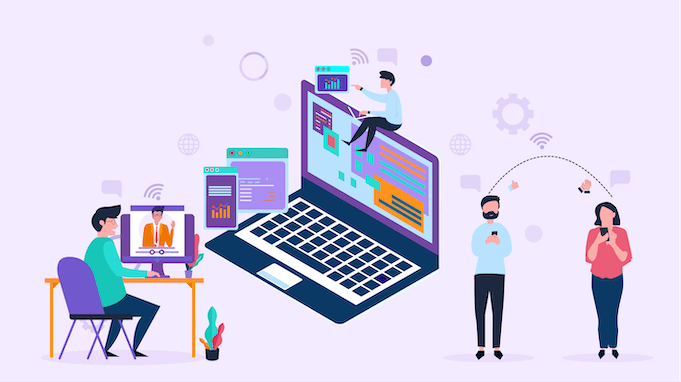Technology has revolutionized the workforce, transforming how businesses operate, how employees perform their tasks, and how industries evolve. With rapid advancements in artificial intelligence (AI), automation, cloud computing, and remote collaboration tools, technology has significantly increased productivity, efficiency, and flexibility in the workplace.
The Role of Technology in the Modern Workforce
The Impact of Technology on Productivity
Technology has streamlined operations across various industries, enabling employees to work smarter and faster. Automation tools and software reduce the time required for repetitive tasks, allowing workers to focus on higher-value activities. Businesses that embrace technology-driven solutions experience increased efficiency, better workflow management, and enhanced decision-making capabilities.
Some key ways technology has improved productivity include:
- Automation of Repetitive Tasks – Many businesses use automation to handle tasks that previously required manual effort. AI-powered chatbots, for example, manage customer inquiries, reducing the workload on human support teams and allowing employees to focus on complex issues that require a personalized touch.
- Project Management Software – Tools like Trello, Asana, and Monday.com enhance organization and collaboration by helping teams track progress, set deadlines, and assign tasks efficiently. These tools reduce communication gaps and ensure everyone is aligned with project goals.
- Data Analytics for Informed Decision-Making – Businesses now rely on big data analytics to analyze large amounts of information efficiently. Data-driven insights allow companies to make more strategic decisions, optimize performance, and predict market trends.
Remote Work and Digital Collaboration
The rise of remote work has been largely facilitated by technological advancements. In the past, working from home was rare due to communication and operational limitations. However, modern digital tools have made remote work seamless, improving collaboration and flexibility for employees and employers alike.
Key Technologies Supporting Remote Work
- Video Conferencing Platforms – Applications like Zoom, Microsoft Teams, and Google Meet have made virtual meetings more accessible, enabling teams to communicate effectively from anywhere in the world.
- Cloud-Based Collaboration Tools – Platforms such as Google Drive, Dropbox, and OneDrive allow employees to store, share, and edit documents in real-time, eliminating the need for physical office spaces and paper-based workflows.
- Virtual Private Networks (VPNs) and Cybersecurity Tools – Secure remote access solutions ensure that employees can safely connect to corporate systems while working from home, protecting sensitive data from cyber threats.
The shift to remote work has also had significant benefits, including increased employee satisfaction, cost savings for businesses, and access to a global talent pool. However, it also presents challenges, such as maintaining company culture, ensuring cybersecurity, and managing remote teams effectively.
Automation and Artificial Intelligence in the Workforce
AI and automation are reshaping job roles by handling repetitive and labor-intensive tasks. While this can lead to job displacement in some areas, it also creates new opportunities for workers to focus on strategic and creative tasks. Industries that have greatly benefited from AI integration include:
- Manufacturing – Robotics and automated machinery streamline assembly lines and production processes, reducing human error and increasing efficiency.
- Healthcare – AI assists in diagnosing diseases, analyzing medical records, and even performing robotic-assisted surgeries, improving patient outcomes and healthcare delivery.
- Finance – Automated trading systems, fraud detection algorithms, and AI-driven risk analysis tools help financial institutions manage investments and prevent security breaches.
Although AI presents numerous advantages, its implementation must be balanced with employee retraining programs to ensure workers can adapt to new roles and responsibilities in an automated environment.
Cybersecurity Challenges and Solutions
As technology advances, so do cybersecurity threats. Businesses must implement strong security measures to protect their digital assets and ensure data privacy. The rise of cybercrime, ransomware attacks, and data breaches highlights the need for proactive cybersecurity strategies.
Common Cybersecurity Threats
- Phishing Attacks – Cybercriminals use deceptive emails and messages to trick employees into revealing sensitive information.
- Ransomware Attacks – Malicious software encrypts an organization’s data, demanding payment for its release.
- Data Breaches – Unauthorized access to company databases can lead to the loss of confidential customer and business information.
Effective Cybersecurity Measures
To mitigate these risks, businesses should implement the following security practices:
- Multi-Factor Authentication (MFA) – Requiring multiple forms of verification prevents unauthorized access to sensitive systems.
- Regular Software Updates – Keeping software and systems up to date helps patch vulnerabilities that hackers may exploit.
- Employee Training and Awareness – Educating employees on cybersecurity threats ensures they can recognize and respond to potential risks effectively.
With the growing importance of cybersecurity, companies must invest in advanced threat detection systems and robust security frameworks to safeguard their digital infrastructure.
The Future of Technology in the Workforce
The integration of emerging technologies like blockchain, quantum computing, and the Internet of Things (IoT) will continue to shape the workforce. These advancements promise to revolutionize industries by enhancing security, efficiency, and connectivity.
Key Emerging Technologies
- Blockchain Technology – Known for its secure and decentralized structure, blockchain is transforming financial transactions, supply chain management, and digital contracts.
- Quantum Computing – This powerful computing technology has the potential to solve complex problems at unprecedented speeds, impacting industries such as pharmaceuticals, cybersecurity, and artificial intelligence.
- Internet of Things (IoT) – IoT devices connect physical objects to the internet, allowing businesses to collect real-time data and optimize operations, from smart manufacturing to energy-efficient buildings.
Preparing for the Future
As technology continues to evolve, businesses must:
- Invest in Employee Training – Upskilling and reskilling programs help workers adapt to technological advancements and maintain employability in a changing job market.
- Encourage Innovation – Companies that foster a culture of innovation are more likely to stay competitive and embrace new technological trends.
- Adopt Agile Work Models – Flexibility in work structures, such as hybrid models that combine remote and in-office work, will allow businesses to adapt to future technological shifts.
Conclusion
Technology has significantly reshaped the workforce, improving productivity, enabling remote collaboration, and automating routine tasks. While advancements such as AI and cybersecurity solutions present new challenges, they also create opportunities for businesses to innovate and remain competitive.
To thrive in the future workforce, organizations must embrace technological change, invest in employee development, and implement strong cybersecurity measures. By staying adaptable and forward-thinking, businesses and employees can harness the power of technology to drive success in an increasingly digital world.
Play More, Win More: GameZone and Tongits Plus

Looking for the ultimate Tongits experience? GameZone and Tongits Plus offer the best of both worlds. With GameZone, you get a feature-rich platform with competitive tournaments, daily rewards, and a seamless gaming experience. Meanwhile, Tongits Plus brings a fresh and exciting way to enjoy your favorite card game with exclusive promotions and a vibrant community.
Why choose one when you can have both? Play on GameZone for high-stakes action and test your skills in Tongits Plus for more fun and rewards. Maximize your winnings and enjoy the best online Tongits experience today!
Add Business Connect magazine to your Google News feed
Must Read:
- Athena Behavioral Health
- Unpacking the Surge: Key Drivers Behind the Oil Industry Boom
- Effortless Health: Easy Tips to Get Healthier in 2024
- Unlocking the Importance of Sleep: Essential Tips for Better Rest
- Top educational games for kids: Combining fun and learning introduction
- Things You Should Never Say If You Want Your Child to Be Successful
- Top 10 World’s Most Expensive Shoes and heels



